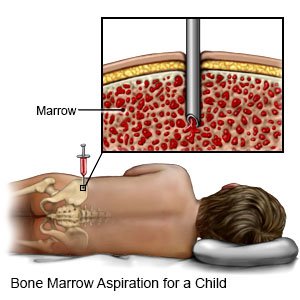Acute Lymphocytic Leukemia in Children
Medically reviewed by Drugs.com. Last updated on Aug 4, 2025.
Acute lymphoblastic leukemia (ALL) is a type of cancer that affects the blood and bone marrow. The bone marrow makes white blood cells (WBC), red blood cells (RBC), and platelets. WBCs help fight infection. RBCs help to carry oxygen throughout the body. Platelets help the blood clot. ALL causes your child's body to make too many immature (young) white blood cells. These cells are cancer (leukemia) cells and cannot fight infection like healthy WBCs. Cancer cells crowd the bone marrow and prevent it from making healthy blood cells. Without enough healthy blood cells, your child is at risk for infection, bleeding, and anemia. Anemia is a low level of red blood cells.
WHILE YOU ARE HERE:
Informed consent
is a legal document that explains the tests, treatments, or procedures that your child may need. Informed consent means you understand what will be done and can make decisions about what you want. You give your permission when you sign the consent form. You can have someone sign this form for you if you are not able to sign it. You have the right to understand your child's medical care in words you know. Before you sign the consent form, understand the risks and benefits of what will be done to your child. Make sure all of your questions are answered.
Stay with your child for comfort and support
as often as possible while he or she is in the hospital. Ask another family member or someone close to the family to stay with your child when you cannot be there. Bring items from home that will comfort your child, such as a favorite blanket or toy.
Reverse isolation
may be needed if your child's body is having a hard time fighting infections. Your child will be given a private room to protect him or her from other people's germs. Healthcare providers and visitors may wear gloves, a face mask, or a gown to keep their germs away from your child. Everyone should wash their hands when entering and leaving your child's room.
Long-term IV catheter:
An IV catheter may be placed into a large vein in your child's body. It is usually placed in the arm or chest. Your child may have this IV catheter for several months. It will be used for chemotherapy and to take blood samples.
Related medications
Medicines:
- Antibiotics help treat or prevent a bacterial infection.
- Antifungal medicine helps treat or prevent a fungal infection.
- Antinausea medicine may be given to calm your child's stomach and prevent vomiting.
- Pain medicine may be given. Do not wait until your child's pain is severe before you ask for more medicine.
Tests:
- Blood tests check your child's blood cell levels.
- X-rays check for swollen lymph nodes in your child's chest.
- A bone marrow biopsy is a procedure to take a sample of bone marrow from your child's hip bone. This test helps healthcare providers find out which type of leukemia your child has.

- A lumbar puncture is a procedure to remove fluid from around your child's spinal cord. The fluid can be tested for cancer.
Treatment:
- Supportive care includes medicines and blood transfusions. Medicines may be given to prevent infections. Blood transfusions may be given to increase your child's level of red blood cells, white blood cells, or platelets.
- Chemotherapy is the main treatment used to kill cancer cells. Your child's healthcare provider may give him or her different types of chemotherapy. Ask your child's provider for more information about the types of chemotherapy.
- Targeted therapy is medicine that finds and kills cancer cells.
- Radiation therapy shrinks tumors and kills cancer cells with x-rays or gamma rays. It may be given alone or with chemotherapy to treat cancer.
- A stem cell transplant is a procedure to replace cancer cells with healthy blood cells. Stem cells are taken from a donor and injected into your child's blood. The stem cells go to his or her bone marrow and become new, healthy blood cells.
Treatment options
The following list of medications are related to or used in the treatment of this condition.
RISKS:
Your child may have pain, discomfort, or fatigue from treatment. Even with treatment, ALL may not go away, or it may return. Cancer treatment may cause new cancer or problems in your child's heart, liver, or blood vessels. Treatment may also cause problems with your child's memory or learning.
CARE AGREEMENT:
You have the right to help plan your child's care. Learn about your child's health condition and how it may be treated. Discuss treatment options with your child's healthcare providers to decide what care you want for your child.© Copyright Merative 2025 Information is for End User's use only and may not be sold, redistributed or otherwise used for commercial purposes.
The above information is an educational aid only. It is not intended as medical advice for individual conditions or treatments. Talk to your doctor, nurse or pharmacist before following any medical regimen to see if it is safe and effective for you.
Learn more about Acute Lymphocytic Leukemia
Treatment options
Symptoms and treatments
Further information
Always consult your healthcare provider to ensure the information displayed on this page applies to your personal circumstances.
